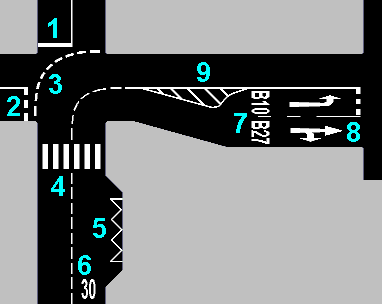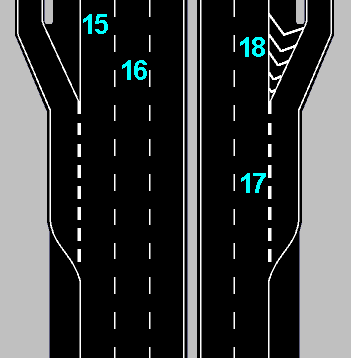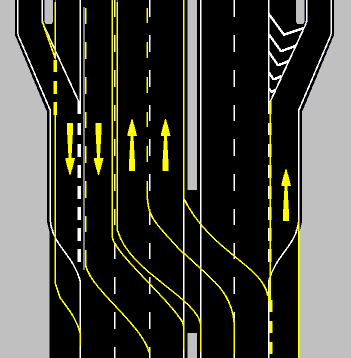
| Home : Driving : Signs & Signals : Page 4 |
| GERMAN TRAFFIC SIGNS, SIGNALS, & MARKINGS |
 |
Skip back to Page 1 of Signs | |
| SIGNALS |
(Items marked with this
symbol ![]() are especially important for US
visitors.)
are especially important for US
visitors.)
Traffic signals in Germany are usually located on same side of the intersection as the approaching traffic and are often mounted overhead as well as on the right and left sides of the road.
|
|
|
|||||||||
Figure 3 |
In the case of left turns, the signal in Figure 3 indicates a protected left turn. |
|
 Figure 6 |
 Figure 7 |
 Figure 8 |
 Figure 9 |
 Figure 10 |
Germany also uses lane control signals in some areas, especially at customs posts and along the Autobahn to indicate lane closures. They use the standard international symbols. See the electronic signs page for further information.
| ROAD MARKINGS |
Road pavement markings in Germany are generally similar to those in the US. Unlike the US, however, all regular road markings in Germany are white, include those used to separate opposing traffic. Yellow road markings are used in construction areas and supercede the regular white markings. Below are diagrams and descriptions of most of the road markings you will encounter in Germany. The light blue numbers on the diagrams correspond to the explanations.
 |
1- Stop line: You
must stop behind the thick solid line across your lane.
2- Wait line: A thick broken line across your lane is the equivalent to a yield sign (and is often used in conjunction with it.) If necessary, you must wait behind the broken line across your lane. 3- Priority road: A broken line passing through an intersection along the edge of one of the roadways indicates the path of the priority road. 4- Pedestrian crosswalk: Zebra-striped markings across the roadway mark a pedestrian crosswalk. You must yield the right-of-way to pedestrians in the crosswalk. 5- No stopping/parking zone: Zig-zag lines next to the curb mark a specific area (often near a near a bus stop or driveway) where you may not stop or park. 6- Numbers: Numbers on the pavement in your lane usually indicate the speed limit. Often used during sudden drops in the speed limit for safety reasons. 7- Letters and numbers: A combination of letters and numbers on the pavement usually indicate route numbers. These are frequently used at complicated intersections to get traffic in the correct lane. Example: a marking such as "B27" indicates that the lane you are in follows the B27 highway. 8- Intersection arrows: Arrows on the pavement in your lane indicate which turns are allowed from your lane. 9- Restricted zone: You may not drive in an area with diagonal lines. |
 |
10- No passing in one direction:
You may pass only if you
have a broken line on your side. You may not cross a solid line on your
side to pass.
11- No passing: You may not cross the solid center line to pass. 12- Merge arrow: An arrow slanting toward the right in the center of the roadway warns passing traffic to merge to the right as a no passing zone is approaching. 13- Lane separation line: Short broken lines between opposing traffic lanes indicate that the passing zone is ending. 14- Lane separation line: Long broken lines between opposing traffic lanes indicate passing is allowed (unless prohibited by a sign). This marking is also used to separate traffic lanes traveling in the same direction. |
 |
15- Edge marking: A
solid line along the side of the roadway marks the edge of the roadway
or separates the travel lanes from the shoulder.
16- Lane separators: Long broken lines separate traffic lanes traveling in the same direction. 17- Acceleration/deceleration lane: Short, thick broken white lines separate a deceleration (exit) lane or acceleration (entrance) lane from the main traffic lanes. 18- Restricted zone: You may not drive in an area with diagonal lines. |
 |
Yellow markings: Yellow road markings are used in construction areas. These markings supercede all of the white markings. Yellow markings may consist of traffic paint or raised pavement markers. |
Colored curb markings are not used in Germany. Head-in and parallel parking lines are obvious and similar to those used in the US.
Lane assignments
On streets not signed as one-way, here are the default lane assignments based on the number of marked lanes on the street:
Odd lane arrangements or assignments
are usually marked fairly obviously, either on the road surface or by signs
(i.e. ![]() )
)
 |
Skip back to Page 1 of Signs |
Home : Driving in Germany : Signs & Signals
© This page and all of its contents are Copyright 2002 by Brian K. Purcell
NOTICE: The information contained on this site is provided "as-is". Although I make reasonable efforts to keep it updated, I make no guarantee regarding accuracy and assume no responsibility for inconveniences or other issues arising from its use. All opinions expressed are strictly my own.